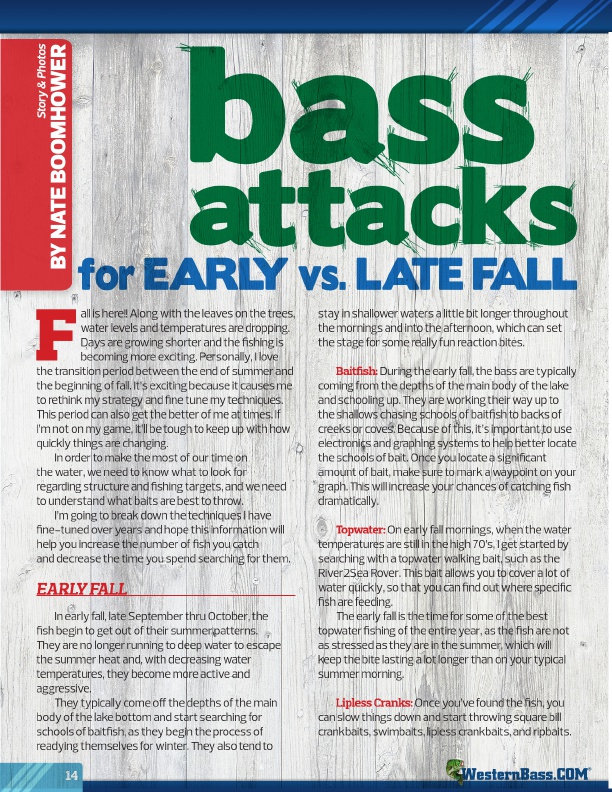
Story & Photos
BY NATE BOOMHOWER
F
all is here!! Along with the leaves on the trees,
water levels and temperatures are dropping.
Days are growing shorter and the fishing is
becoming more exciting. Personally, I love the transition period between the end of summer and
the beginning of fall. It’s exciting because it causes me
to rethink my strategy and fine tune my techniques.
This period can also get the better of me at times. If
I’m not on my game, it’ll be tough to keep up with how
quickly things are changing.
In order to make the most of our time on
the water, we need to know what to look for
regarding structure and fishing targets, and we need
to understand what baits are best to throw.
I’m going to break down the techniques I have
fine-tuned over years and hope this information will
help you increase the number of fish you catch
and decrease the time you spend searching for them.
EARLY FALL
In early fall, late September thru October, the fish begin to get out of their summer patterns. They are no longer running to deep water to escape the summer heat and, with decreasing water temperatures, they become more active and aggressive.
They typically come off the depths of the main body of the lake bottom and start searching for schools of baitfish, as they begin the process of readying themselves for winter. They also tend to
14
stay in shallower waters a little bit longer throughout the mornings and into the afternoon, which can set the stage for some really fun reaction bites.
Baitfish: During the early fall, the bass are typically coming from the depths of the main body of the lake and schooling up. They are working their way up to the shallows chasing schools of baitfish to backs of creeks or coves. Because of this, it’s important to use electronics and graphing systems to help better locate the schools of bait. Once you locate a significant amount of bait, make sure to mark a waypoint on your graph. This will increase your chances of catching fish dramatically.
Topwater: On early fall mornings, when the water temperatures are still in the high 70’s, I get started by searching with a topwater walking bait, such as the River2Sea Rover. This bait allows you to cover a lot of water quickly, so that you can find out where specific fish are feeding.
The early fall is the time for some of the best topwater fishing of the entire year, as the fish are not as stressed as they are in the summer, which will keep the bite lasting a lot longer than on your typical summer morning.
Lipless Cranks: Once you’ve found the fish, you can slow things down and start throwing square bill crankbaits, swimbaits, lipless crankbaits, and ripbaits.
®